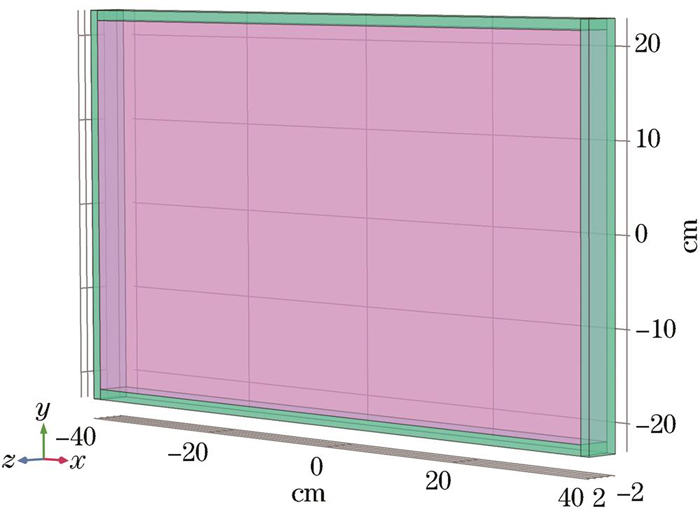Jixi Xu, Xin Wang, Jingping Tang, Wei Chen, Shubin Chen, Lili Hu. Effect of Asymmetry in Cooling on Residual Temperature Field of an N41-Type Neodymium Glass Main Amplifier Slab[J]. Laser & Optoelectronics Progress, 2023, 60(21): 2116001
Search by keywords or author
- Laser & Optoelectronics Progress
- Vol. 60, Issue 21, 2116001 (2023)

Fig. 1. Model of Nd-glass main amplifier slab. Nd-glass plate has dimension of 786 mm×436 mm×40 mm, whose four edges are bonded with 12 mm thick edge-cladding glass by epoxy glue, and origin of coordinates is located at geometric center

Fig. 2. Temperature distribution in xy section (z=0) of N41-type Nd-glass main amplifier slab at different time after pumping. Heat transfer coefficient of Nd-glass surface is 2.5 W/(m2·K). (a)‒(e) Heat transfer coefficient of edge-cladding of Nd-glass is 2.5 W/(m2·K); (f)‒(j) heat transfer coefficient of edge-cladding of Nd-glass is 30 W/(m2·K)
Fig. 3. Temperature field distribution of N41-type Nd-glass main amplifier slab at thermal recovery state under asymmetric cooling at xy profile with z=0. Heat transfer coefficient of Nd-glass surface is 2.5 W/(m2·K). (a) Up side is 2 W/(m2·K), bottom side is 3 W/(m2·K), and left and right sides linearly transit from 2 to 3 W/(m2·K); (b) up side is 4 W/(m2.K), bottom side is 6 W/(m2·K), and left and right sides linearly transit from 4 to 6 W/(m2·K); (c) up side is 12 W/(m2·K), bottom side is 18 W/(m2·K), and left and right sides linearly transit from 12 to 18 W/(m2·K); (d) up side is 20 W/m2K, bottom side is 30 W/m2K, and left and right sides linearly transit from 20 to 30 W/(m2·K)
Fig. 4. (a) Average temperature rise and (b) temperature difference between upper-corner point and down-corner point of N41-type Nd-glass main amplifier slab under unsymmetrical edge cooling conditions
Fig. 5. Relationship between (a) slab-equilibration time and (b) self-equilibration time of N41-type Nd-glass main amplifier slab and heat transfer coefficient applied to surfaces of edge-cladding. Heat transfer coefficient applied to Nd-glass optical pass surface is 2.5 W/(m2·K)
Fig. 6. Conducted heat energy when N41-type Nd-glass main amplifier slab transmits through Nd-glass optical pass surface, short edge-cladding interface, and long edge-cladding interface. Heat transfer coefficient of Nd-glass is 2.5 W/(m2·K). Heat transfer coefficient of edge-cladding is (a) 2.5 W/(m2·K); (b) 5 W/(m2·K); (c) 15 W/(m2·K); (d) 30 W/(m2·K). Heat flux from edge-cladding to Nd-glass is negative and on the contrary, it is positive
Fig. 7. N41-type Nd-glass main amplifier slab dissipates heat energy outward through (a) short edge-cladding interface, (b) long edge-cladding interface, (c) Nd-glass optical pass surface, and (d) all interfaces of Nd-glass. Heat transfer coefficient applied to Nd-glass surface is 2.5 W/(m2·K), and heat transfer coefficient applied to edge-cladding surface is from 2.5 to 30 W/(m2·K)
| |||||||||||||||||||||||||||||||||||||||||||||||
Table 1. Thermal recovery characteristic time of N41-type Nd-glass main amplifier slab under four kinds of unsymmetrical edge cooling conditions

Set citation alerts for the article
Please enter your email address



